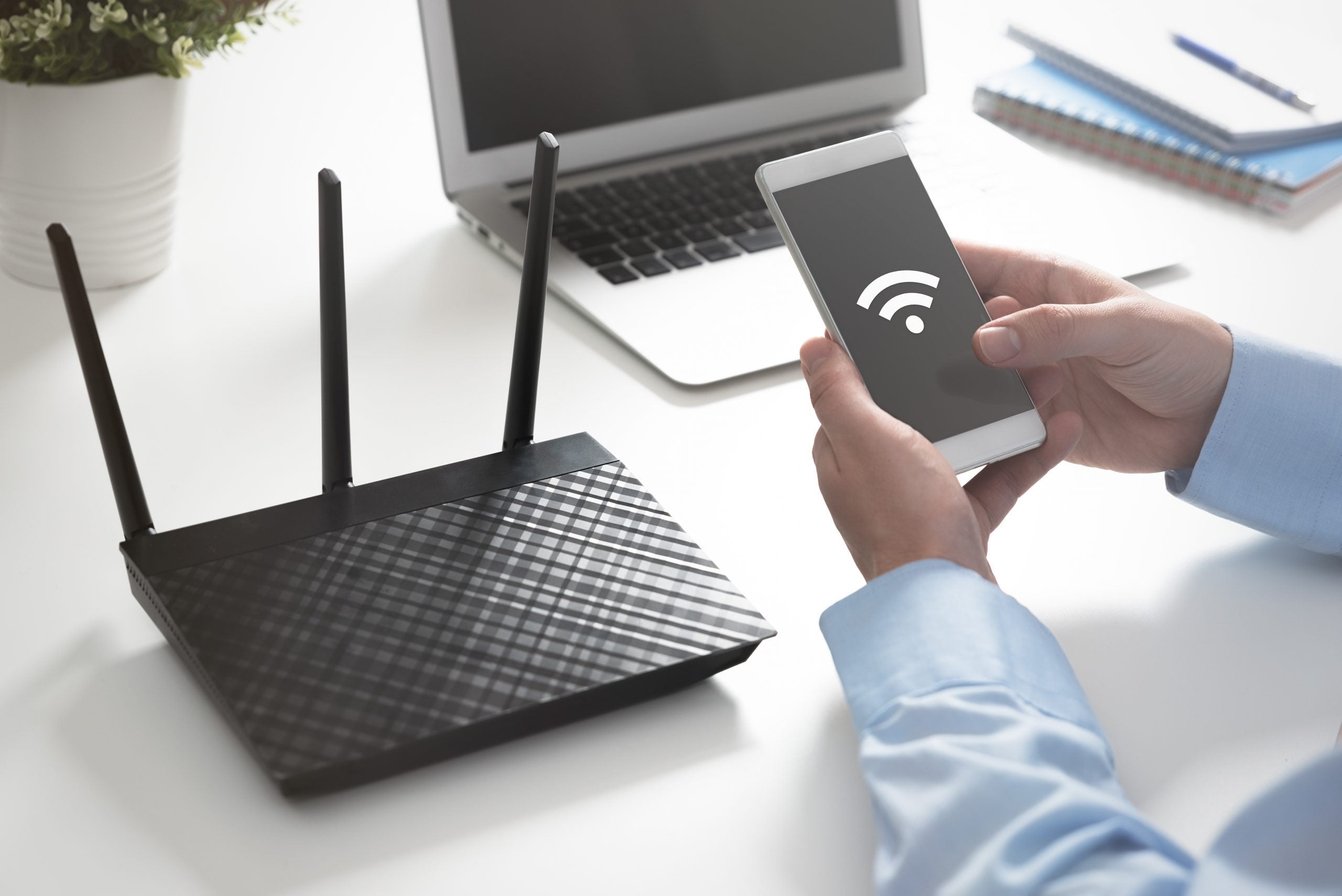As modern technology continues to evolve, it can be pretty challenging to understand what all of the terms being used actually mean. In order to make sure that you are getting the most out of your internet as possible, you will need to stay up to date on all the words and phrases associated with technology.
One word that you have probably heard before is “bandwidth.” Although it might seem a little intimidating at first, the concept of bandwidth is actually fairly simple and straightforward.
Bandwidth is a measurement of the maximum capacity that a computer network can transfer information. People often perform a speed test on their server to see how quickly things load and how strong the signal is. A computer network is a group of two or more devices that transfer data in order to communicate with each other. The more bandwidth that this computer network has, the more data that can be sent and received at one time. This is a sign of good network performance.
An easy way to visualize it would be to picture traffic on the highway. If cars and other vehicles represent various data and information, then bandwidth would be the amount of lanes on the road.
If the road is spread out and contains many lanes of traffic (representing a higher level of bandwidth), then more traffic (data) will be able to travel quickly in order to get where they are going. If there are less lanes of traffic (representing a lower level of a bandwidth) then the rate of travel would severely decline. The traffic (data) would be slowed down and jammed up, requiring a longer amount of time to travel down the road to the destination.
Interestingly enough, bandwidth is used in signal processing as well. It describes the frequencies in transmission (which is measured in hertz).
Just like any other method of measurement, bandwidth is measured by its own unique unit. Just like a distance might be measured in inches or weight might be measured in pounds, bandwidth is measured by bits. More accurately it’s measured by bits per second (Bps). The more bits of information being transferred per second, the faster the internet will run in any given amount of time.
Since there is so much information that is being sent and received, bandwidth is usually measured in kilobits (Kbps), which are 1,000 bits per second. There aren’t too many features online that require less than a few dozen Kbps and so this is typically the smallest measurement that you will see.
Usually, bandwidth will be measured in the millions of bits per second. Once the transfer rate reaches over a million bits, it is now classified as a megabit (Mbps). This means that a bandwidth running at 1.4 megabits would actually be 1.4 million bits of information being transferred per second.
In some cases, an internet connection might even achieve a bandwidth that reaches billions of bits per second. These are known as gigabits (Gbps) and have an incredibly large data transfer rate.
Although often used interchangeably, there is a difference between the speed of a connection and the bandwidth. Advertisements by various internet service providers will usually use the term “speed” when bandwidth would technically be more accurate. Speed will generally refer to the rate that data can be transmitted while bandwidth is the maximum capacity for that speed.
Using the previous metaphor of traffic, speed is how fast the cars are traveling down the road while bandwidth is the total amount of cars that could be traveling down the road at any given moment.
It’s important to note that just because you have a higher bandwidth usage, it doesn’t necessarily mean higher speed for your wireless network. The device you are using, what you are trying to do, and the quality of the router that you have can all play a role. A larger bandwidth would simply mean that you would be capable of transferring a large amount of data more quickly.
Depending on how you are using the internet, you might require a much larger bandwidth than others. Certain activities online, such as streaming Netflix, media, or downloading a movie, will take up much more bandwidth than simply surfing around the web. This affects your download speeds, upload speeds, and the quality of service. Another factor is the number of devices that are connected to the network.
There is only so much bandwidth to go around (a maximum amount of data) and the more devices that are connected to it, the less information will be transferred to each and the connection will be slower.
This is known as latency and refers to the delay that you may experience while waiting for the information you are receiving to arrive. Latency is a very common problem in households with too little bandwidth for their users or activities. For example, having a bandwidth of 20 Mbps that is shared by two devices could easily support one user streaming videos while the other was browsing online.
However, the same bandwidth would not be enough to support six users that are trying to play video games online, stream videos, and download files at the same time. The latency and lagging for each of these activities would be extremely high and severely limit the functions of the various devices being used.
In general, the Federal Communications Commission recommends using an internet bandwidth of around 12 to 25 Mbps for a family of four with light use. For heavier internet usage, or more than four users/devices, it’s recommended to use a bandwidth of more than 25 Mbps.
Depending on the activity that you are engaging in, you might be using a much different amount of bandwidth than you think. It’s always best to have more bandwidth than you need, but some activities online don’t require nearly as much bandwidth as others. Here is a quick breakdown of the more common activities performed using a network connection and how much bandwidth they typically require:
-Streaming videos online will require more bandwidth than most other activities. Although the streaming service will play a part, the most important factor is the definition of the video. Streaming a standard definition video will require around three or four Mbps, but high definition (HD) nearly doubles the requirement to between five and eight Mbps. In order to stream a video in Ultra HD 4K, it could take as much as 25 Mbps. This is why running internet speed tests is important.
-Online gaming is a popular recreational activity and the amount of bandwidth required can vary. For most consoles, it will require around three Mbps to connect to the internet and another Mbps to play multiplayer games with others. The overall amount of bandwidth could grow depending on a few factors such as the visual definition of the game and console being used.
-Surfing the web is one of the best ways to utilize an internet connection. In order to do so properly and avoid long loading times for the various sites that you visit, it will require around one or two Mbps of bandwidth.
-Streaming music will require less bandwidth than video because it’s only audio information and has no visual components. As a result, you will only need around 500 Kbps (0.5 Mbps) in order to stream. However, some services and apps might require as many as two Mbps in order to run properly.
-Video conferencing is very commonly used today and doesn’t take up as much bandwidth as you may think. It usually only ranges from 500 Kbps (0.5 Mbps) to 1.5 Mbps. Of course, the overall bandwidth required might increase if you are using high-definition teleconference options and have multiple people tuning in. Even with these factors added in, video conferencing should only require around six Mbps to function properly.
-Email and instant messaging are easy ways to communicate with the people in your life and will hardly use any bandwidth in the process. Sending a standard email or message with no attachments only requires around 80 Kbps.
If you have an internet plan that should provide enough bandwidth for your activities but are still experience latency issues, there are a few quick fixes available:
-Move the router. The router should be placed in an open space with as few obstructions around it as possible. Your network connection will be much stronger when there are fewer objects between your device and router.
-Reboot your router. A common fix for technology is simply turning it off and restarting it. Unplug your router and let it sit for about 15 minutes. Plug it back in and see if the issue is resolved.
-Buy a better router. Using an outdated or low-quality router can severely limit your bandwidth capabilities. Buying a high-quality router can provide a much better experience with the internet.
-Plug in directly. Going wireless will mean that you lose some of your bandwidth, but plugging directly into the router will help with device congestion and prevent connection issues.
Bandwidth is a very common term used in the world of technology. Although it’s often confused for other meanings, it refers to the maximum amount of information that can be transferred via a network connection over a set amount of time.
The higher that your bandwidth capabilities are, the more information that you will be able to receive in a shorter amount of time. There are plenty of factors that can hinder or limit the amount of bandwidth you have. In some cases, it’s the router being used to spread that information from the internet to your device. Using a higher-quality router can help to maximize your bandwidth capabilities.
Sources:
Bandwidth Definition
What is Bandwidth? - Definition and Details
What is network bandwidth and how is it measured?
What is latency? | How to fix latency
Household Broadband Guide
Broadband Speed Guide
How To Increase Bandwidth: 15 Best Tips
One word that you have probably heard before is “bandwidth.” Although it might seem a little intimidating at first, the concept of bandwidth is actually fairly simple and straightforward.
What Is Bandwidth?
Bandwidth is a measurement of the maximum capacity that a computer network can transfer information. People often perform a speed test on their server to see how quickly things load and how strong the signal is. A computer network is a group of two or more devices that transfer data in order to communicate with each other. The more bandwidth that this computer network has, the more data that can be sent and received at one time. This is a sign of good network performance.
An easy way to visualize it would be to picture traffic on the highway. If cars and other vehicles represent various data and information, then bandwidth would be the amount of lanes on the road.
If the road is spread out and contains many lanes of traffic (representing a higher level of bandwidth), then more traffic (data) will be able to travel quickly in order to get where they are going. If there are less lanes of traffic (representing a lower level of a bandwidth) then the rate of travel would severely decline. The traffic (data) would be slowed down and jammed up, requiring a longer amount of time to travel down the road to the destination.
Interestingly enough, bandwidth is used in signal processing as well. It describes the frequencies in transmission (which is measured in hertz).
How Is Bandwidth Measured?
Just like any other method of measurement, bandwidth is measured by its own unique unit. Just like a distance might be measured in inches or weight might be measured in pounds, bandwidth is measured by bits. More accurately it’s measured by bits per second (Bps). The more bits of information being transferred per second, the faster the internet will run in any given amount of time.
Since there is so much information that is being sent and received, bandwidth is usually measured in kilobits (Kbps), which are 1,000 bits per second. There aren’t too many features online that require less than a few dozen Kbps and so this is typically the smallest measurement that you will see.
Usually, bandwidth will be measured in the millions of bits per second. Once the transfer rate reaches over a million bits, it is now classified as a megabit (Mbps). This means that a bandwidth running at 1.4 megabits would actually be 1.4 million bits of information being transferred per second.
In some cases, an internet connection might even achieve a bandwidth that reaches billions of bits per second. These are known as gigabits (Gbps) and have an incredibly large data transfer rate.
Are Bandwidth and Speed the Same Thing?
Although often used interchangeably, there is a difference between the speed of a connection and the bandwidth. Advertisements by various internet service providers will usually use the term “speed” when bandwidth would technically be more accurate. Speed will generally refer to the rate that data can be transmitted while bandwidth is the maximum capacity for that speed.
Using the previous metaphor of traffic, speed is how fast the cars are traveling down the road while bandwidth is the total amount of cars that could be traveling down the road at any given moment.
It’s important to note that just because you have a higher bandwidth usage, it doesn’t necessarily mean higher speed for your wireless network. The device you are using, what you are trying to do, and the quality of the router that you have can all play a role. A larger bandwidth would simply mean that you would be capable of transferring a large amount of data more quickly.
How Much Bandwidth Do You Need To Have?
Depending on how you are using the internet, you might require a much larger bandwidth than others. Certain activities online, such as streaming Netflix, media, or downloading a movie, will take up much more bandwidth than simply surfing around the web. This affects your download speeds, upload speeds, and the quality of service. Another factor is the number of devices that are connected to the network.
There is only so much bandwidth to go around (a maximum amount of data) and the more devices that are connected to it, the less information will be transferred to each and the connection will be slower.
This is known as latency and refers to the delay that you may experience while waiting for the information you are receiving to arrive. Latency is a very common problem in households with too little bandwidth for their users or activities. For example, having a bandwidth of 20 Mbps that is shared by two devices could easily support one user streaming videos while the other was browsing online.
However, the same bandwidth would not be enough to support six users that are trying to play video games online, stream videos, and download files at the same time. The latency and lagging for each of these activities would be extremely high and severely limit the functions of the various devices being used.
In general, the Federal Communications Commission recommends using an internet bandwidth of around 12 to 25 Mbps for a family of four with light use. For heavier internet usage, or more than four users/devices, it’s recommended to use a bandwidth of more than 25 Mbps.
How Much Bandwidth Are You Using?
Depending on the activity that you are engaging in, you might be using a much different amount of bandwidth than you think. It’s always best to have more bandwidth than you need, but some activities online don’t require nearly as much bandwidth as others. Here is a quick breakdown of the more common activities performed using a network connection and how much bandwidth they typically require:
-Streaming videos online will require more bandwidth than most other activities. Although the streaming service will play a part, the most important factor is the definition of the video. Streaming a standard definition video will require around three or four Mbps, but high definition (HD) nearly doubles the requirement to between five and eight Mbps. In order to stream a video in Ultra HD 4K, it could take as much as 25 Mbps. This is why running internet speed tests is important.
-Online gaming is a popular recreational activity and the amount of bandwidth required can vary. For most consoles, it will require around three Mbps to connect to the internet and another Mbps to play multiplayer games with others. The overall amount of bandwidth could grow depending on a few factors such as the visual definition of the game and console being used.
-Surfing the web is one of the best ways to utilize an internet connection. In order to do so properly and avoid long loading times for the various sites that you visit, it will require around one or two Mbps of bandwidth.
-Streaming music will require less bandwidth than video because it’s only audio information and has no visual components. As a result, you will only need around 500 Kbps (0.5 Mbps) in order to stream. However, some services and apps might require as many as two Mbps in order to run properly.
-Video conferencing is very commonly used today and doesn’t take up as much bandwidth as you may think. It usually only ranges from 500 Kbps (0.5 Mbps) to 1.5 Mbps. Of course, the overall bandwidth required might increase if you are using high-definition teleconference options and have multiple people tuning in. Even with these factors added in, video conferencing should only require around six Mbps to function properly.
-Email and instant messaging are easy ways to communicate with the people in your life and will hardly use any bandwidth in the process. Sending a standard email or message with no attachments only requires around 80 Kbps.
Ways That You Can Increase Your Bandwidth
If you have an internet plan that should provide enough bandwidth for your activities but are still experience latency issues, there are a few quick fixes available:
-Move the router. The router should be placed in an open space with as few obstructions around it as possible. Your network connection will be much stronger when there are fewer objects between your device and router.
-Reboot your router. A common fix for technology is simply turning it off and restarting it. Unplug your router and let it sit for about 15 minutes. Plug it back in and see if the issue is resolved.
-Buy a better router. Using an outdated or low-quality router can severely limit your bandwidth capabilities. Buying a high-quality router can provide a much better experience with the internet.
-Plug in directly. Going wireless will mean that you lose some of your bandwidth, but plugging directly into the router will help with device congestion and prevent connection issues.
The Takeaway
Bandwidth is a very common term used in the world of technology. Although it’s often confused for other meanings, it refers to the maximum amount of information that can be transferred via a network connection over a set amount of time.
The higher that your bandwidth capabilities are, the more information that you will be able to receive in a shorter amount of time. There are plenty of factors that can hinder or limit the amount of bandwidth you have. In some cases, it’s the router being used to spread that information from the internet to your device. Using a higher-quality router can help to maximize your bandwidth capabilities.
Sources:
Bandwidth Definition
What is Bandwidth? - Definition and Details
What is network bandwidth and how is it measured?
What is latency? | How to fix latency
Household Broadband Guide
Broadband Speed Guide
How To Increase Bandwidth: 15 Best Tips




